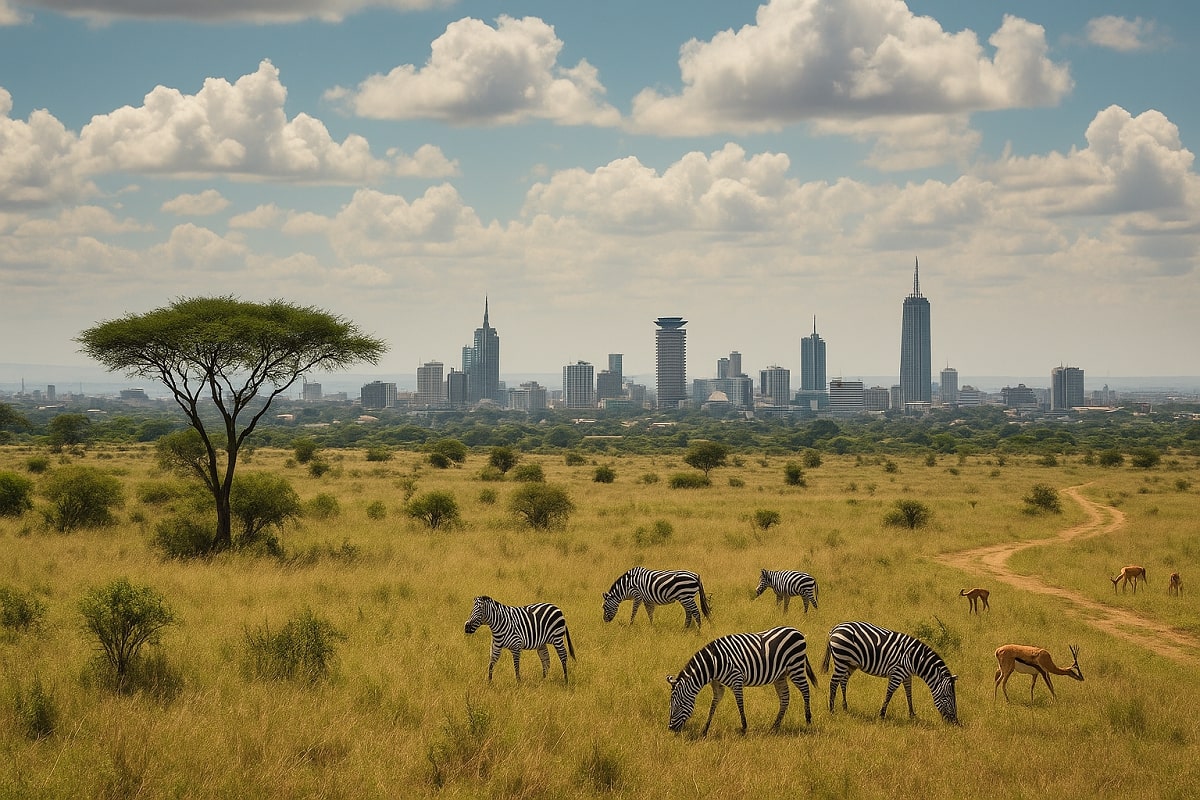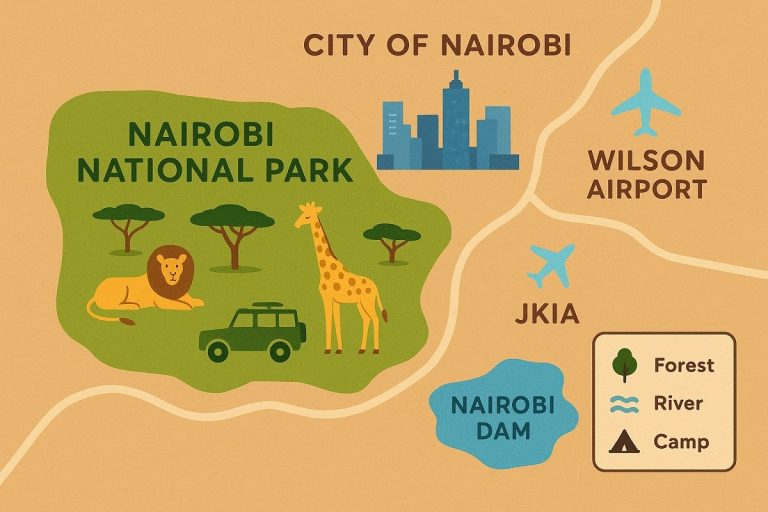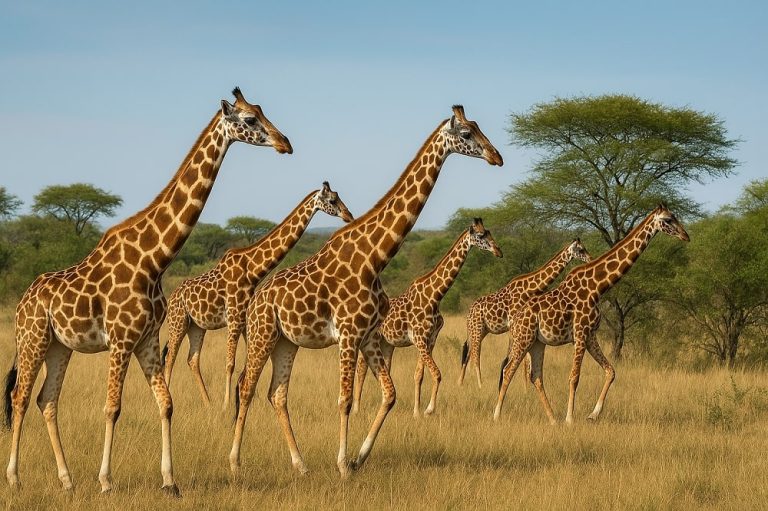Nairobi National Park in Kenya

Imagine standing on the edge of Africa’s only wildlife park that borders a bustling capital city (Nairobi). At a distance, skyscrapers rise and lions among other wild animals roam freely in the foreground. This is Nairobi National Park, a remarkable sanctuary just 7 km from Nairobi’s Central Business District, offering you an unforgettable blend of urban and wild Africa.
Covering 117 square kilometers, the park may be smaller than many of Kenya’s famous reserves, but its biodiversity is astonishing. It is home to over 100 species of mammals, including endangered black rhinos, majestic lions, elegant giraffes, and vast herds of zebras and buffalo. Bird lovers will be equally thrilled, with more than 400 recorded species that include the vivid lilac-breasted roller to impressive raptors like the martial eagle.
Nairobi National Park is truly special because of its accessibility. You don’t need days of travel to get there. In fact, you could land at Jomo Kenyatta International Airport in the morning, enjoy a game drive by midday, and be back in time for an evening dinner at the city. This proximity makes it perfect for day trips, weekend getaways, and quick wildlife fixes for travelers with limited time.
This amazing park offers more than just wildlife. It is a living reminder of Kenya’s conservation history being the country’s first national park and established in 1946. Its open grass plains, acacia woodlands, and seasonal rivers paint a picture of an ecosystem in delicate balance.
A balance that thrives despite the constant pressure of an expanding metropolis. If you’re an international tourist chasing the “Big Five,” a photographer seeking that perfect sunrise shot, or a Nairobi resident in need of a quick escape, Nairobi National Park delivers an adventure that feels both intimate and grand.
Quick Facts about Nairobi National Park
The Nairobi National Park is one of Kenya’s tourism treasure. Here are some facts about this historic park that could interest you.
- Location: Just 7 km south of Nairobi’s city center, Kenya.
- Established: 1946 — Kenya’s first national park.
- Size: 117 km² (45 sq. miles).
- Elevation: About 1,795 meters (5,889 ft) above sea level.
- Ecosystem: Open grass plains, scattered acacia bush, seasonal rivers, and dams.
- Wildlife Highlights: Black rhino, lion, leopard, cheetah, giraffe, buffalo, zebra, eland, and over 400 bird species.
- Best Time to Visit: June to September (dry season for easy wildlife spotting) and January to February.
- Unique Feature: The only national park in the world bordering a capital city skyline.
- Main Entrance Gates: Main Gate (KWS HQ), East Gate, Langata Gate, and Maasai Gate.
- Nearest Airport: Jomo Kenyatta International Airport (approximately 20 minutes by car).
Why Visit Nairobi National Park?
Few places on earth offer the thrill of watching wild lions prowl against the backdrop of a modern city skyline. Nairobi National Park is one of them. It is the only capital city in the world where you can be on a game drive in the morning and back at your downtown hotel or conference by lunch.
I have been to this park many times and below I share with you reasons I believe you should visit the park and why it’s worth a spot on your travel bucket list:
- Wildlife on Your Doorstep: It is home to over 100 mammal species, including the Big Four (lion, leopard, buffalo, rhino), plus giraffes, zebras, and cheetahs, all roaming freely just minutes from Nairobi CBD.
- Iconic City–Savannah Contrast: Where else can you snap photos of grazing giraffes with skyscrapers in the background? This unique juxtaposition makes for unforgettable memories and world-class photography. If you are a photography lover and enthusiast, come and take picturesque and memorable photos at this park.
- Easy Accessibility: No need for long road trips or bush flights. You can land at Jomo Kenyatta International Airport and be inside the park in under 30 minutes. This convinience offers you an opportunity to start your tour on a high note.
- Birdwatcher’s Paradise: With over 400 recorded bird species, the park is a hotspot for both casual bird lovers and serious ornithologists. If you are into bird watching, this is the place for you.
- Year-Round Destination: It does not matter the time you visit. The dry season is best for game viewing while the wet season is great for lush scenery and migratory birds, the park never loses its charm. You will love it any time you visit it.
For first-time safari-goers, it’s the perfect introduction to Kenya’s wildlife. For seasoned travelers, it’s a fascinating reminder that nature and modern life can still exist side by side if we choose to protect it.
Best Time to Visit Nairobi National Park
Nairobi National Park is open year-round, but when you visit can greatly shape your experience. The park’s proximity to the equator means consistent daylight hours, yet seasonal changes bring distinct wildlife and scenic variations.
Dry Season (June to September & January to February) – Best for Game Viewing
- Why visit now: The grass is short, vegetation is sparse, and water sources shrink this drawing animals closer to the few remaining waterholes. This makes it easier for you to spot lions lounging in the open, rhinos grazing, and large herds of herbivores moving together.
- Weather: Warm, dry days with cool mornings and evenings.
- Extra perk: Photographers love the golden light of the dry season, which adds drama and beuaty to sunrise and sunset shots against the city skyline.
Wet Season (March to May & October to December) – Lush Landscapes & Birds
- Why visit now: The “long rains” (March–May) and “short rains” (Oct–Dec) transform the park into a vibrant green paradise. Migratory birds from Europe and Asia arrive, making it a hotspot for birdwatching.
- Wildlife factor: While tall grass can make spotting predators more challenging, the scenery is stunning, and newborn animals are often seen after the rains.
- Bonus: Fewer tourists, so you’ll enjoy quieter game drives and better chances to linger at sightings.
Special Seasonal Highlights
- July–August: Good chance to see some wildebeest movement into the park from the Athi-Kapiti plains that are south of the park.
- April–May: Ideal for birders due to peak migratory season and lush backdrops.
- January–February: Warm, clear days perfect for short-stay visitors combining the park with city activities.
Travel Tip: Even in the dry season, mornings can be chilly – pack a light jacket for early game drives. And if visiting in the wet season, a waterproof jacket and closed shoes are a must.
How to Get There
Nairobi National Park is one of the easiest safari destinations in Kenya to reach. Imgine you could be watching lions within 30 minutes of leaving the city centre. The main entrance is located just 7 km south of Nairobi’s CBD, making it perfect for short trips or even half-day safaris.
From Nairobi CBD
- By Car/Taxi: A 20–30 minute drive via Langata Road takes you straight to the Main Gate. The route is well-signposted and passes notable city landmarks.
- By Public Transport: Matatus (local minibuses) heading toward Lang’ata or Karen can drop you near the main entrance, but for convenience and safety, most tourists prefer private taxis, Uber, or Bolt.
Coming From Jomo Kenyatta International Airport (JKIA)
- Distance: About 15 km to the Main Gate.
- Travel Time: 25–40 minutes, depending on traffic. This makes it possible to fit in a quick game drive during a long layover.
- Tip: Many tour companies offer “airport-to-park” packages that handle both transport and park entry.
From Wilson Airport
- Distance: Roughly 7 km — around 10–15 minutes by car.
- Why it matters: Wilson is the hub for domestic and regional safari flights, so many travelers combine their Nairobi National Park visit with flights to Maasai Mara or Amboseli.
Park Entrances
Nairobi National Park has multiple entry gates, but the most commonly used are:
- Main Gate (Lang’ata Road) – Closest to the CBD, museums, and tourist attractions.
- East Gate (Airport Side) – Convenient for visitors coming from JKIA or Mombasa Road.
- Langata Gate – Sometimes used for specialized tours and access to nearby attractions.
Navigation Tip: Nairobi traffic can be unpredictable, especially during rush hours (7–9 am and 5–7 pm). Plan your arrival early in the morning to catch the best wildlife activity and avoid delays.
Park Entry Fees (2025)
Below I share with you a detailed Nairobi National Park entry fees guide. This will help you plan accordingly…
Official KWS Rates
- Citizen / East African Residents (Kenya, Uganda, Tanzania, Rwanda, Burundi, South Sudan):
- Adults: KSH 430
- Children (3–17 years): KSH 215
- Non-Resident International Visitors:
- Adults: US$ 43
- Children: US$ 22
Payment Tips
- Payments are now cashless only, accepted via the KWS eCitizen portal, through M-Pesa, Visa cards, or EFT.
- It’s recommended to pay beforehand online for smoother entry.
Vehicle Charges (Per Day)
| Vehicle Type | Fee (KSH) |
| ≤ 6 seats (car/small SUV) | 300 |
| 6–12 seats (minibus/van) | 1,030 |
| 13–24 seats (bus) | 2,585 |
| 25–44 seats (bus) | 4,050 |
| ≥ 45 seats (coach) | 5,000 |
Quick Cost Example
A non-resident adult in a small car would pay approximately:
- US$ 43 (entry fee) + KSH 300 (vehicle fee) ≈ US$ 45–46 total (approx. KSH 5,300).
Proposed Fee Adjustments (2024–2025)
The Kenya Wildlife Service is currently reviewing and inviting public feedback on proposed fee changes from July to August 2025. These may significantly increase charges, so they’re worth monitoring, especially if you’re planning ahead. Proposed new adult entry fees could be KSH 2,000 for residents and US$ 50–100 for international visitors, depending on the season. Be on the alert.
Top Things to Do at the Nairobi National Park
Nairobi National Park offers you far more than a simple game drive. Its compact size, diverse habitats, and close proximity to the capital make it easy for you to pack in multiple memorable experiences, even if you only have half a day to visit the park.
Here are the top activities worth adding to your itinerary:
1. Game Drives (Self-Drive or Guided)
The classic way to explore the park is on a game drive.
- What to expect: Spotting iconic African wildlife like lions, buffalo, giraffes, and black rhinos — all with the Nairobi skyline in the background.
- Best time: Early mornings (6:00–9:00 a.m.) or late afternoons when animals are most active.
- Tip: If you don’t have your own 4×4, hire a guide or tour vehicle for the best sightings and insights.
2. Walking Safari at the Ivory Burning Site
This historical spot marks where the late President Daniel arap Moi (second president of the republic of Kenya) set fire to ivory in 1989 as a statement against poaching.
- Experience: Short interpretive trails and information boards make it a great stop for photography and learning.
- Tip: Wear comfortable shoes and bring water — Nairobi’s sun can be deceptively strong.
3. Picnic at Designated Sites
Enjoy a meal surrounded by nature. Popular picnic areas include Kingfisher, Impala Point, and Mokoyiet.
- Why it’s special: You get sweeping views of the savannah and might even spot wildlife passing by.
- Tip: Carry your own food and drinks — there are no restaurants inside the park.
4. Birdwatching
With over 400 recorded bird species, Nairobi National Park is a birder’s paradise, especially between November and April when migratory species arrive.
- Highlights: Secretary birds, crowned cranes, and lilac-breasted rollers.
- Tip: Bring binoculars and a camera with a zoom lens for the best experience.
5. Safari Walk (Adjacent to the Main Gate)
The Nairobi Safari Walk offers an immersive, raised boardwalk experience with caged and open enclosures featuring cheetahs, lions, and more.
- Why visit: It’s perfect for families and those short on time who still want a close look at wildlife.
- Tip: Pair it with a visit to the Animal Orphanage next door for rescued wildlife encounters.
6. Photography
From sunrise silhouettes of giraffes to dramatic city-meets-wilderness scenes, the park is a photographer’s dream.
Tip: Use a long lens for wildlife close-ups and a wide-angle lens for skyline shots. Early morning light gives the best colors.
Wildlife You Might See at the Nairobi National Park
Despite being just a few kilometers from Nairobi’s skyscrapers, the park is teeming with wildlife. It’s one of the best places in Kenya for you to enjoy a real safari without venturing far from the city.
Here’s what you can expect to spot on your visit:
Big Cats
- Lions – Nairobi National Park is home to about 30–40 lions, often spotted lounging in the grasslands or hunting early in the morning.
- Leopards – Much rarer and elusive, but lucky visitors sometimes glimpse them in wooded areas or near river valleys.
- Cheetahs – Occasional sightings in the open plains, though less common than lions.
Rhinos
- The park is a black rhino sanctuary, hosting one of the largest populations in Kenya.
- Black rhinos are browsers with hooked lips, while the fewer white rhinos are grazers with square lips. Seeing them against the city skyline is a signature Nairobi National Park experience.
Elephants? Not Here
Unlike many Kenyan parks, Nairobi National Park does not have elephants. This makes it unique – it is a safari with plenty of variety but manageable for its size.
Other Large Mammals
- Cape buffalo – Abundant and often in large herds.
- Giraffes – Maasai giraffes tower above the acacia trees, often spotted browsing calmly.
- Zebras, wildebeest, and hartebeest – Grazing herds dominate the savannah.
- Elands and waterbucks – Graceful antelopes seen near rivers and wooded areas.
Birdlife
With over 400 bird species, Nairobi National Park is a birder’s dream:
- Residents: Ostriches, crowned cranes, secretary birds, and hornbills.
- Migratory species: Arrive between November and April, making this period especially rich for birdwatchers.
Smaller Carnivores
- Jackals, hyenas, and even the occasional aardwolf roam the park.
- Servals and mongoose species can also be spotted if you’re patient.
The mix of savannah, woodland, and river habitats means every game drive can be different. One morning you might spot a lion pride, while the next you’ll marvel at rhinos grazing in front of Nairobi’s skyline.
Practical Tips for Visiting Nairobi National Park
A safari in Nairobi National Park may be close to the city, but it’s still a wild adventure. These tips will help you get the best out of your visit:
What to Wear
- Neutral-colored clothing – Stick to khaki, brown, green, or grey. Bright colors (especially red and blue) can attract insects or spook animals.
- Layers – Mornings can be chilly, while midday gets hot. A light jacket or sweater is handy.
- Comfortable shoes – Sneakers or light boots are best if you’ll explore picnic sites or short trails.
Sun Protection
- Nairobi sits on the equator, and the sun can be intense. Carry:
- A wide-brimmed hat or cap
- Sunglasses
- Sunscreen (SPF 30+)
Photography Gear
- A good camera with zoom lens is ideal, but even smartphones capture stunning shots, especially with the city skyline in the background.
- Binoculars are a must for birdwatchers.
Getting Around
- Self-drive is possible, but ensure your car is sturdy enough for dirt tracks, especially after rain.
- Many visitors prefer guided game drives with experienced rangers who know where to find the animals.
Timing Your Visit
- Morning (6:30–10 am) – Best for spotting lions and other predators before the heat of the day.
- Late afternoon (3–6 pm) – Great for grazing animals and photography in golden light.
Food and Refreshments
- Carry snacks and water.
- There are designated picnic sites (like Kingfisher, Impala, and Mokoyiet) where you can enjoy a meal safely.
Safety Tips
- Always stay inside your vehicle during game drives unless at designated areas.
- Keep noise to a minimum; animals are sensitive to disturbance.
- Do not feed or approach wildlife – for your safety and theirs too.
Payments
- No cash at the gates — entry fees are paid via Mpesa, debit/credit card, or eCitizen.
These practical insights make the park more approachable for first-time tourists and even locals looking for a quick nature getaway.
Nearby Attractions to Combine with a Nairobi National Park Tour
One of the best things about Nairobi National Park is its proximity to other must-see attractions in the city. If you’re planning a visit, consider adding these stops to your itinerary:
David Sheldrick Elephant Orphanage
- Located right next to the park, this sanctuary rescues and rehabilitates orphaned baby elephants.
- Visitors can watch the calves being fed and playing in the mud between 11 am and 12 pm daily.
- A touching experience that highlights Kenya’s conservation efforts.
- About 30 minutes from the park in Karen, this center lets you get up close with endangered Rothschild’s giraffes.
- You can hand-feed them from an elevated platform and learn about giraffe conservation.
- Perfect for families and photo lovers.
Nairobi Safari Walk
- Adjacent to the park’s main gate, this raised wooden boardwalk offers a mini-safari on foot.
- It features a mix of wildlife enclosures, nature trails, and botanical gardens – great for kids and educational tours.
Bomas of Kenya
- A cultural center showcasing Kenya’s diverse traditions through dance, music, and homestead replicas.
- Located just a short drive away, it’s a great way to mix wildlife with culture in one day.
Karen Blixen Museum
- The former home of Danish author Karen Blixen (famous for Out of Africa).
- A must-visit for history and literature lovers.
These nearby attractions make it easy to create a full Nairobi day tour — morning safari, midday elephant orphanage visit, and afternoon giraffe encounter, topped off with dinner in Karen.
Bottom Line: A Safari Like No Other
Nairobi National Park proves that you don’t have to travel far to experience the magic of the African wild. Just a short drive from the city center, you can find yourself watching lions hunt at dawn, spotting giraffes grazing against the Nairobi skyline, or listening to the calls of over 400 bird species.
For both locals and international travelers, the park offers a rare mix of convenience and adventure. It is versatile – if you have only half a day or an entire weekend, it delivers an unforgettable safari without the long travel hours to distant reserves. And with nearby attractions like the David Sheldrick Elephant Orphanage and Giraffe Centre, it’s easy to turn your visit into a full cultural and wildlife experience.
Ready to plan your trip?
This blog post is just the beginning. We have amzing Kenya travel Guidebooks that touch on the park in a an indepth manner. In addition, we also have Kenya Travel Tips to help you in the planning stage of your Kenya Safari and, Kenya Travel Maps to act as a physical guide to different travel destinations in Kenya.
To even make it complete, we have a complete, in-depth Nairobi National Park and its environs map that’s packed with insider aspects like photography spots, camping sites, picnic sites, roads, amd much more. This map is your key to making the most out of your Nairobi safari adventure. If you need assistance or have any question, kindly reach out to us now.


